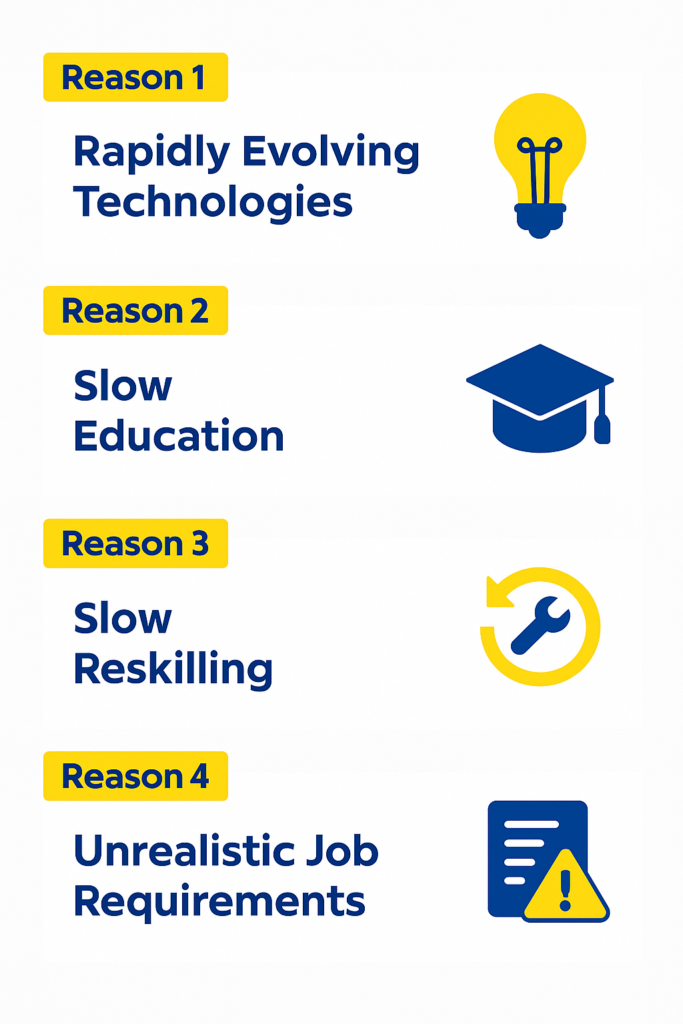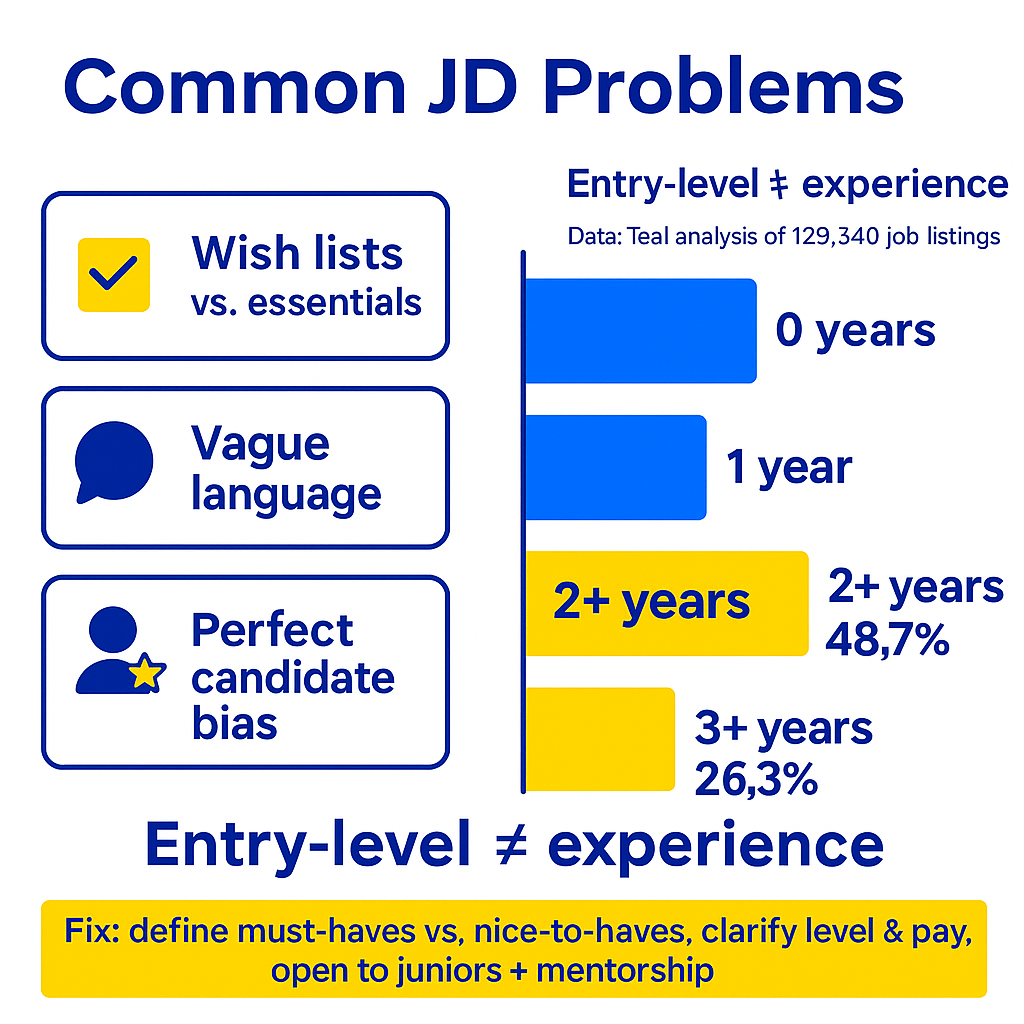The IT skill gap is real. There is a demonstrable IT skill gap, but its complexity extends beyond a simple shortage of talent. While companies urgently require up-to-date tech skills for product launches and contract fulfillment, many simultaneously create job descriptions demanding an unrealistic depth of experience, the so-called “unicorn” roles.
This paradoxical approach, an attempt to cut costs and mitigate turnover risk by targeting only the elite, exacerbates the very problem it seeks to solve.
The IT skills gap is not a singular issue. It’s forged by four factors: rapid technological change, the education system’s slowness to adapt, insufficient workplace reskilling efforts, and exaggerated employer expectations. Together, these four horsemen of the apocalypse create a chasm between the capabilities employers need and what the current workforce can provide.
To fully grasp this crisis, this article analyzes these aspects shaping the gap, including the state of the job market, accelerating technology development, and recent massive layoffs.
Why is There a Skills Gap in the IT Industry?
The IT skills gap is caused by a combination of four factors: rapid technological change, the education system’s slowness to adapt, insufficient workplace training, and exaggerated employer expectations. Together, they create a disconnect between the skills employers need and what the workforce can provide.

Around 74% of IT leaders detected a skill gap in their workforce, according to CompTIA. According to Forbes UK, 93% of businesses say there is an IT skills gap.
Reason 1: Rapid Evolving Technologies
New technologies like AI, cloud computing, and cybersecurity are constantly evolving, making it hard for existing workforces and education systems to keep up.
A 2024 survey by Pluralsight found that half of current tech workers struggle to learn fast enough to keep pace with rapid technological changes. Moreover, 31% of aspiring IT workers feel that they can’t learn fast enough to keep pace.
This is due to the increasing workloads, as shown in a PwC survey, and the shrinking “half-life” of skills, with some technologies becoming outdated in as little as 2.5 years. The rapid advancements in areas like AI, cybersecurity, and cloud computing require continuous upskilling to remain relevant.
Reason 2: Slow Education
Universities struggle to keep pace with the rapid changes in IT due to systemic challenges, including slow curriculum approval processes, a primary focus on theoretical fundamentals and research over immediate industry applications, a shortage of qualified faculty, and limited financial resources.
The process for updating academic programs and courses is often slow, involving bureaucratic red tape, numerous faculty approvals, and accreditation agency reviews. By the time a new curriculum is approved, the technology it covers may already be obsolete in the fast-moving tech industry.
UNESCO Global Education Monitoring Report (2023) states that the fast pace of change in technology is putting strain on education systems (not only universities) to adapt. It notes that many teachers feel unprepared and lack confidence using technology, and only half of the countries have standards for developing Information and Communication Technology (ICT) skills.
CHLOE 10 Report found that institutions of higher education can barely keep pace with student demand for online learning and that most remain structurally unprepared for the necessary transformation. The co-author, Dr. Bethany Simunich, noted that “colleges struggle to meet legitimate demand” and tend to “scramble to catch up when disruption becomes unavoidable”.
According to CHLOE 10, only 28% of faculties are fully prepared for online course design, and 45% for teaching. To add salt to injury, 28% of institutions report having fully developed academic continuity plans for future online courses.
Reason 3: Slow Reskilling
In short, the scale and speed of the changes driven by AI and cost-cutting are outstripping the effectiveness of traditional reskilling programs. A World Economic Forum survey found that around 40% of workers who require reskilling can be reskilled for new roles in completely different functions in just six months on average.
The need for reskilling is urgent because the “half-life” of technical skills will be transformed or become outdated over the 2025-2030 period. IT workers can expect that two-fifths (39%) of their existing skill set will become obsolete, according to the World Economic Forum.
According to TTMS, the estimated time for reskilling program development is from a few days to a few weeks for a one-hour course, to several months for more complex reskilling programs.
Unsurprisingly, just hiring a new IT worker with the skills is time-saving, even while you consider onboarding and adaptation time.
That being said, companies are still willing to reskill their experts. IBM pledged in October 2021 to provide 30 million people worldwide with digital skills by 2030. Cisco aims to train 25 million people in cybersecurity and digital skills by 2032 through its Cisco Networking Academy program. Microsoft is committed to training and certifying 10 million people in digital skills by 2025 and has surpassed this goal, reaching 12.6 million people a year ahead of schedule.
Reskilling might be going slower than we wish, but the biggest companies are working to improve it as much as they can.
Reason 4: Unrealistic Job Requirements
As the cherry on top of this crisis, the combination of dizzying technological acceleration and a slow-moving educational system leaves entry-level workers hobbled by a massive IT skill gap. Even senior professionals aren’t immune, often struggling to keep pace. The surreal result is that employers desperately try to apply a band-aid to a gaping wound, setting impossible job requirements with a small salary, simply hoping someone will bite.
Employers have unrealistic expectations over job requirements, a mix of “wish lists” versus essential needs, vague language, and a desire for a “perfect” candidate. This is a source of frustration for both job seekers and new hires, according to Teal. They checked 129,340 job listings across 21 industries, 118 roles, and major job boards like LinkedIn, Indeed, and Built In.

According to their study, nearly half (48.7%) of entry-level job postings require at least two years of experience, while 26.3% require 3+ years. The job market is trying to hire seniors at an entry-level salary.
With such expectations, no wonder they can’t find their employee and end up hiring no one. It’s frustrating for both hiring managers and candidates, which may exaggerate the perception of the skill gap. Sometimes you just need to lower your entry bar for entry-level job postings. You can’t have seniors if the market doesn’t skill up the juniors. Therefore, the company that trains its juniors will have a leverage.
How to Survive the IT Skill Gap Crisis?
To survive the IT skill gap crisis, companies must be strategic to maintain growth, while IT candidates can leverage the demand to advance their careers.
Advice for IT Candidates: Capitalize on the Demand
The skill gap creates an excellent market for skilled IT professionals. Focus on continuous learning and strategic specialization to maximize your value.
1. Master High-Demand and Emerging Skills
Identify and gain proficiency in the technologies that businesses are actively struggling to hire for. These are the Holy Trinity of the IT Abilities for 2025:
- Cloud computing platforms (AWS, Azure, GCP),
- Cybersecurity (zero-trust, threat hunting),
- Data/AI (machine learning, Generative AI)
Get certified and pursue other recognized industry certifications (e.g., CompTIA, Cisco, Microsoft, AWS) to validate your expertise quickly. Don’t forget to keep studying and sustain the validity of your certifications.
Finally, remember that technical skills get you the interview, but soft skills get you the job and promotion. Focus on problem-solving, communication, adaptability, and digital business acumen (understanding how tech drives business value).
2. Embrace a Culture of Continuous Learning
Technology evolves rapidly, so your current skills have a short shelf life. Allocate time each week for courses, documentation, and side projects that expose you to new technologies. Participate in company-sponsored upskilling programs, mentorships, and cross-training opportunities.
For your continuous learning, compare your current skills to the requirements in job descriptions for your target role. Then, create a measurable plan for acquiring the missing skills. A good example would be: “Complete ‘Cloud Architect’ certification within 6 months”.
Advice for Business Owners: Build, Borrow, and Buy Talent
Traditional recruitment alone won’t solve the skill gap. A multi-pronged strategy focusing on internal development, flexible work models, and an improved employee experience is essential.
1. Prioritize “Build” (Upskill and Reskill)
Developing your existing workforce is often more cost-effective and improves retention. Offer clear, structured pathways for current employees to gain new, in-demand technical skills. This is the most sustainable long-term solution.
Also, create formal programs for employees to move into new IT roles or projects, providing opportunities for hands-on, experiential learning. Focus on skills and aptitude rather than rigid job titles and degrees. Be willing to hire high-potential candidates and train them.
2. Strategically “Borrow” and “Buy” Talent
Use external resources and adjust compensation to bridge immediate needs. Embrace remote work and flexible hours to access a wider geographical talent pool. Utilize staff augmentation services for short-term projects or highly specialized needs.
Moreover, ensure your salary and benefits packages are highly competitive and reflect the market value of critical IT skills to attract and retain top talent. A good way to do it while saving costs is by hiring professionals from nearshore or offshore countries; you can get an expert for half the cost of an onshore worker.
3. Focus on Retention and Employer Branding
Employees stay when they see a future. Provide transparent career progression and development opportunities that don’t always require a move into management (e.g., Senior/Principal Individual Contributor tracks).
Plus, provide mentorship, flexible work arrangements, and a supportive culture. High-value work and recognition are often as important as salary.
Finally, simplify your recruitment process. Lengthy, complex hiring experiences can cause top candidates to accept offers elsewhere.
Conclusion
“Is there an IT skill gap?” can be definitively answered with a resounding yes, but the deeper truth is that this crisis is as much a gap in strategy as it is a shortage of talent.
As we’ve analyzed, the chasm is not merely a consequence of rapid technological change or the slow-moving education system; it is dramatically widened by insufficient workplace reskilling and, most ironically, unrealistic employer expectations.
The quest for the “unicorn” candidate (a senior-level expert willing to accept an entry-level salary) exacerbates the very problem it seeks to solve.
However, there is a way to get a unicorn candidate for an affordable salary without shoving them into an entry-level position, and that is our IT staffing agency. We headhunt and vet only the best candidates in the world. You only pay when you are finally satisfied. And you have a three-month guarantee to take all your money back.
Contact us today, and let’s search for the best IT expert with all the skills you need!





